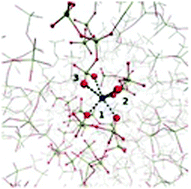Structures and properties of phosphate-based bioactive glasses from computer simulation: a review
Abstract
Phosphate-based bioactive glasses (PBGs) dissolve harmlessly in the body with a dissolution rate which depends sensitively on composition. This makes them proposed vectors for e.g. drug delivery, or other applications where an active component needs to be delivered at a therapeutically appropriate rate. Molecular dynamics (MD) simulations provide atomic-level structural information about PBG compositions. We review recent work to show that MD is an excellent tool to unravel the connections between the PBG glass composition, its atomic structure, and its dissolution rate, which can help to optimise PBGs for specific medical applications.

- This article is part of the themed collection: Recent Review Articles


 Please wait while we load your content...
Please wait while we load your content...